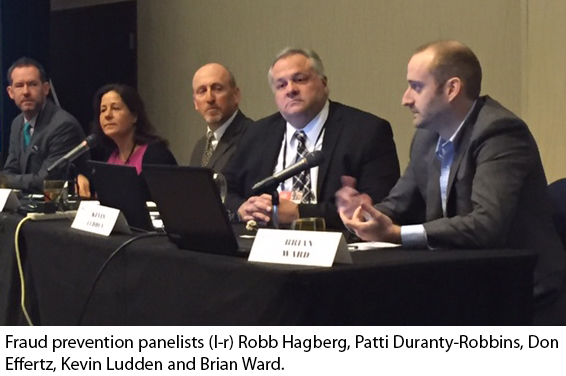
As Mortgages Shift to Purchase Market, So Do Fraud Schemes
MIAMI–“Fraud is beginning to show itself in new and exciting ways,” said Don Effertz, vice president of risk management with DataVerify Inc., Chesterfield, Mo.
What this means, Effertz said here at the recent Mortgage Bankers Association’s Risk Management, QA and Fraud Prevention Forum, is that it’s important for the industry to remain diligent in detecting and mitigating mortgage fraud and keeping it part of the discussion.
 In today’s risk environment, mortgage fraud continues to be prevalent–and lenders cannot afford to remain complacent. Patti Duranty-Robbins, associate vice president and strategy and planning specialist with the enterprise fraud group at PNC Bank, Downers Grove, Ill., said balancing threats and customer needs is a “daunting” task.
In today’s risk environment, mortgage fraud continues to be prevalent–and lenders cannot afford to remain complacent. Patti Duranty-Robbins, associate vice president and strategy and planning specialist with the enterprise fraud group at PNC Bank, Downers Grove, Ill., said balancing threats and customer needs is a “daunting” task.
“Where it was once was decades for things to change, the electronic age allows change in days,” Duranty-Robbins said. “Historically, fraud and misrepresentations were slow to evolve; today, they happen in a flash.”
Brian Ward, director of fraud prevention with Quicken Loans Inc., Detroit, noted with the recent Equifax breach, “roughly half of America has had their identity compromised.”
Kevin Ludden, fraud industry relations manager with Fannie Mae, Washington, D.C., said the company’s tip data provide a solid indicator of projected fraud. For 2017, he said, projections are up. “Of all the tips we’ve received, 10 percent become fraud cases,” he said.
In recent years, Ludden said, REO fraud has decreased substantially, but originations and servicing have seen upticks. Origination spikes, he said, have largely resulted from self-reporting data. “A lot of it was better data collection from our lender partners,” he said.
Fannie Mae also reported appraisal fraud represented the largest attribute of fraud schemes, followed by fraud for qualifying and “straw buyers.” “We’re seeing a return of falsified documents, which appears to be a cyclical issue,” Ludden said. “Straw buyers also raise identity theft issues.”
With the migration from a refinance market to a purchase market, Ludden said it’s important to maintain vigilance. He said even though underwriting has toughened in recent years, fraudsters remain persistent.
“The fraudsters are shifting from refis to purchase–they want to maintain their ‘champagne lifestyle,'” Ludden said. “They will become more sophisticated in their schemes, so you must be more diligent…the more things change, the more they remain the same.”
Robb Hagberg, senior director of fraud risk with Freddie Mac, McLean, Va., agreed while the persistence of fraud hasn’t changed much over the past few years, the sophistication has increased significantly. “We see a higher degree of organization, and patterns of schemes–and our customers are telling us the same thing,” he said.
Hagberg said fraud detection and prevention rest on six key factors:
–Credit policy verbiage: “Does it say what you intend?
–Technology: Do you understand your vulnerabilities? “All of this technology we’re deploying may still be subject to fraud,” Hagberg said.
–KYC (Know Your Customer): Do you really know who you’re working with?
–Underwriter Knowledge/Skills: How deep does it go? “Underwriting is a risk function,” Hagberg said. “If you don’t treat it as a risk function, you are failing your processes.”
–Fraud Controls: Do you have them? Are you keeping them?
–Fraud Schemes: Do you know how they might evolve?
Hagberg also warned that within the industry itself, industry professionals conceal their true identity to circumvent fraud controls, such as watch lists and exclusionary lists. “Maintain your controls where you can see them,” he said. “You are the first line of defense, and if you do not take up the banner and fight this fight, then we are all in trouble.”
